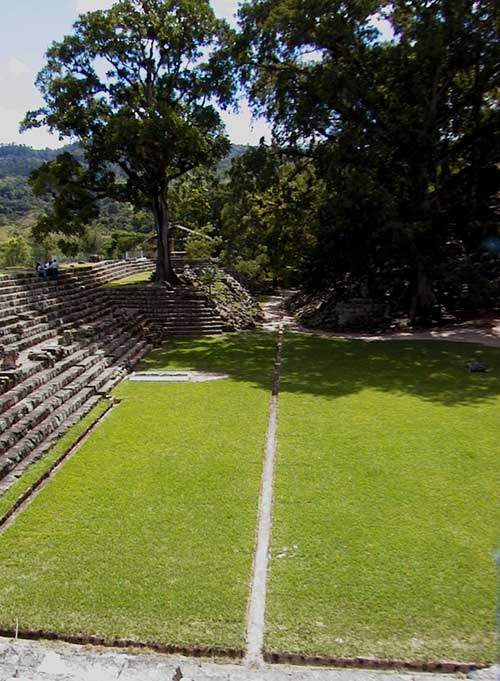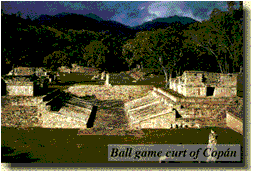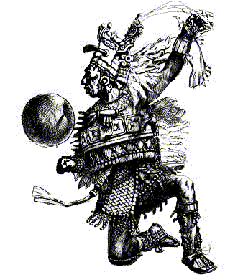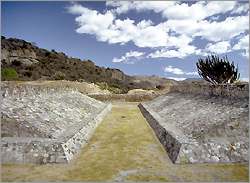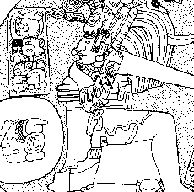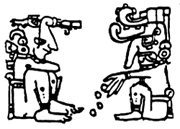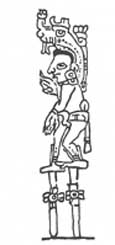| 5-30-00 - DREAM - I saw a large golden-tan letter K in the air
and it began flying around in the air. I was told that there were 5 Mayan
games and I should work on them.
The dream then went into a people dream and I was working for a man who sold toys and games to people. This was my first day on the job and I didn't know where any of his stock as located in the storeroom. I had no previous training to do this. The first 5 people came in and I waited on them all at the same time. I had had management experience so I was prepared with 5 clipboards with the sales paperwork on them and was able to write up the orders efficiently. However, then I had to start hunting for the games and didn't know where they were. The choice game was numbered D17. The others all had numbers from 227 or 427 or so. They were not kept together. Finally, exasperated, after the customers even tried to find the D17 game, I saw a woman friend sitting at a long table playing with the game. It was a plastic hamster and a toy man who was barely taller than the hamster. I asked the woman where she had found the game and she said they were kept in a special cabinet in the corner. I looked where she pointed and the cabinet was the same color as the letter K was earlier - golden/tan and was 5 sided. It had a wooden door on the front. I saw where she meant, but there were so many people in the place by now, I didn't know where the customer was that wanted it. I looked into the storeroom and saw that there was a bakery shop attached to this store and that it was now 10 p.m. and found out that the bakery workers had been producing loaves of bread since 5 a.m. without a break. There were hundred of loaves of fresh bread available because sales on Sunday of fresh bread was always the treat of the week when people went home from church.
|
||
The Ball Court at Chichén Itzá
The Mayans were great sportsmen and build huge ballcourts to play their games. The Great Ballcourt of Chichén Itzá is 545 feet long and 225 feet wide overall. It has no vault, no discontinuity between the walls and is totally open to the sky. Each end has a raised "temple" area. A whisper from end can be heard clearly at the other end 500 feet away and through the length and breath of the court. The sound waves are unaffected by wind direction or time of day/night. Archaeologists engaged in the reconstruction noted that the sound transmission became stronger and clearer as they proceeded. (See Comments) Legends say that the the winning captain would present his head to the losing capitan, who then decapitates him. While this may seem a strange reward, the Mayans believed this to be the ultimate honor.The winning captian getting a direct ticket to heaven instead of going through the 13 steps that the Mayan's believed they had to go through in order to reach heaven.. The sacred Ball Court was the site of a brutal Mayan sport. The field, approximately the size of a football field, is bordered by two imposing walls 26 feet tall. Seven combatants on each team tried to get a small rubber ball to go through a small stone hoop 23 feet above the ground supposedly without using their hands or feet to touch the ball. Virtually all descriptions of the native Mexican ballgames stress that hands were not allowed to touch the ball. Yet two 8th century Maya sculptures and several Peten Maya vases show players with their hands on the ball.It is believed that the losers of this game were often sacraficed to the Gods. These Mayan games predate the olympics by about 500 years! The games played in the ballcourt were sometimes played to the death. The Maya central city area was built for religous reasons. Almost every Mayan city had a ballcourt to play the ball game Pok-A-Tok. Pok-A-Tok games were often played as parts of religous ceremonies. Besides this large court, Chichen-Itza has 22 other courts, testimony to the importance of this (blood) sport. Serious injury could be inflicted on a player with the hard ball which was mainly struckwith the elbows, knees or hips, but was not to be hit with the hands, feet or calves. Playerswere known to throw themselves on the ground to hit the ball properly. The full impact of the ball was in this case absorbed by the body. Participants wore equipment for protection, including chin pieces and half masks for cheeks, hard leather gloves, quilted cotton elbowpads, knee pads, belts or yokes made of leather or basketry for the waist a protruding palmate stone, and a leather apron.
Copan Ballcourt Many 8th century Maya vases show entire teams at play: five carved vases are now known for the Yucatan area, several polychrome vases for southern Campeche, and at least ten polychrome vases for the Peten area of Guatemala. Also, the 7th century stucco roof comb statues of Labna once displayed a complete game. This fantastic scene on the Labna flying facade even reveals how the stairways of the ballcourts were used. Several vases also show the role of the stairways for the ceremonies associated with this ritualized sport. The ball court in Copan does not have the rings we normally think of in a Mayan ball court. Instead there are 6 macaw heads (the sacred bird) which were the "goals" to be aimed at. In the official games here the losers were sacrificed — other Mayan areas (with the rings) supposedly sacrificed the winners. See: http://www.maya-art-books.org/html/BALLlec.html#anchor451488 The most recent discovery in ballgame iconography was by Vincent Phillips, who recognized that Stela 66 at Calakmul pictured the dynastic ruler dressed as a ballplayer. This fact had not previously been listed in any publication on Maya stelae. An unexpected discovery from most vases and some sculptures was that many Maya athletes wore the same headdresses as did deer hunters. Several athletes even wear the same rare type of pants that Maya hunters wear. In other cases, ballplayers wear headdresses of warriors. It seems that hunting (whether hunting deer or hunting other men) was one ritual association for ancient ball sports in Mexico. Even more fascinating (and unexpected) is that several vases picture captives playing the game. These vanquished warriors were most likely captured in battle with neighboring Maya cities. These doomed individuals were then sent into the ballcourts for their final combat, as gladiators.
The crucial thing when working with the Maya ballgame is to remember that the Maya played two main kinds of game: handball and "big ball". Their "big ball" game had two main variations, that played by dynastic rulers and that played by other members of the elite. Each variant could be played using either stone yugos low around their waist or wooden ball deflectors high on their chest. There seem to have been three classes of "goals". At the on top of the slanted sides of the ball court are three parrot head markers - these markers were used as scoring devices for the game. The public watched the games from the stairs in front of Stela 2, which lead to the playing field, or the huge staircase that forms what looks like a wall.
Different symbols are brought together in the ball game. Archaeologists think the ball symbolized the sun and the game re-enacted its apparent orbit around the Earth. The sun was worshipped as a god and by playing the game, one became somewhat akin to the Sun-God. But the game might also have signaled a changing season, so that it served a purpose as well. Since agrarian societies require a timekeeper to regulate agricultural tasks, these rituals were vital to the Mayan society's survival. Pre-Columbian ball courts and other buildings functioned both as religious temples and observatories. The architecture was used to define orientations and mark the passage of time. When Orion appeared through a designated hole or the sun shone directly on a specific spot, it meant spring was near. The pyramid of El Taj’n in Mexico, for example, is made up of 365 niches, one for each day of the year. A niche here is the equivalent of a box in one of our calendars. Not knowing evil, their actions were completely innocent and their pleasure was to play ball, the ancient Maya Game. On one level the ball game is an allegory for the movements of the celestial bodies. Perhaps this is why they could play the game in any combination of seven, up to three on one side and four on the other, representing the five closest planets plus the sun and moon, depending on their position in the night sky.
Smaller calendars were sculpted into stone and gold. It is no wonder then
that artists were highly regarded and given special status in Mayan society.
Without artists there would be no calendars, no way to tell time, bad crops
and eventually famine. For the Maya, astronomy was enmeshed into one thick
fabric with art, agriculture and religion.
|
||
| BUL - MAYAN BOARD GAME
Bul (pronounced like 'Bull' ) is an ancient Mayan war game. The dice game is named HAXBIL-BUL and is derived from HAXBIL (drill) and BUL (riddle game), however BUUL is also assigned to grains and we already know how the grains were related to fortunetelling and mathematical calculations that the Spaniards called superstitions. Stewart Culin, an ethnologist and curator of the Brooklyn Institute of Arts and Sciences, included it, as observed among the Kekchi Maya by two different observers, in his great 1907 anthology of Indian games. R.C. Bell included yet another observer's report of the game among the Kekchi in his anthology of the world's great board games. Lieve Verbeeck, a modern Mayan linguist, stumbled across the Belizean version of this game and observed it played by today's Mopan and Kekchi Maya. In a private communication, Lieve wrote: There is no hard evidence that the corn game, as it is now still played by the Mopan and K'ekchi' Mayans, was known in the ancient times. However, there is linguistic evidence that the ancient Mayans used to play games of chance. The name of BUL occurs in several Mayan languages and always means to play with dice. Sometimes, by extension, it means "to lose with gambling". There is archaeological evidence that the Mayans knew the square- and oval-shaped patolli boards. There are many sites throughout the Maya area where archaeologists found patterns of patolli boards carved in floors or benches. Only three Maya manuscripts were safeguarded from the Spanish conquerors. Up till now no reference to Maya board games was found. There are a few pictures displaying priests throwing corn or seeds for divination. See (http://www.halfmoon.org/bul.html). Culin's version of BUL is quite accurate. I observed the game being played by 10 men. They placed 25 grains of corns in a row. The game lasted for 3 hours, because they played 5 variants. Bul seems to reflect ancient Maya warfare
Games of chance were quite popular in a number of Mesoamerican cultures; the Aztecs' addiction to the game of Patolli is well known. The stakes they played for sometimes rose so high that the loser lost not only his wealth but his freedom too, selling himself into slavery to pay his debt. Religious people fiercely disapproved of Patolli because the players invoked the names of Aztec gods during the game. Similar games were played by the classic Maya. "Game boards" have been found scratched into the stone of building floors and the bases of stelae. The Mayan game of Bul is a relative of the Aztec Patolli, with which it shares many common features. In Bul, a "board" was made by placing 15 grains of corn in a row, the 14 spaces between grains being used for play. Four flat grains of corn with a black mark burned into one side served as dice. When the grains were tossed the count was based on the number that fell with the burned side up (1 burned side and 3 unburned = 1, etc.). But if all the kernels came up blank, the count was 5. Bul can be played with any even number of participants. The example used here is the simplest arrangement, with only 2 players. Each player has 5 game pieces; these could be any readily available item: seeds, sticks, bits of cloth, etc. I've represented the pieces as warriors because the language the Maya used while playing Bul seems to have been a metaphor for warfare: game pieces were described as being taken captive or killed. The ancestral use of grains of corn to make their counts seem to be corroborated from diverse sources: Sánchez de Aguilar (3) said that the Mayas "throw their luck with a fistful of corn" and it is very suggestive to read in the Popol Vuh a paragraph where our cosmic grandfathers, Ixpiyacoc and Ixmucané before the formation of the human race, they make an augury based on mysterious calculations using corn grains and tzité. Recinos (4) identifies the tzité as the Erythrina corallodendron - Arbol de Pito, in Guatemala, and "colorín" in Mejico, and states that the fruit is a shell that encapsulates red grains similar to beans which the natives Mayas still use for magical spells. |
